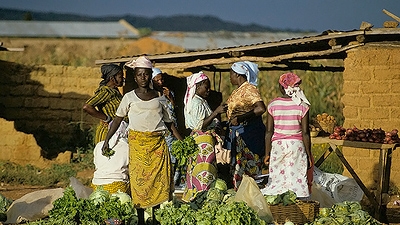The creation of a more nutritious sweet potato biofortified to combat vitamin A deficiency and "scuba" rice varieties designed to withstand flooding are two successful examples of how investing in agriculture research is changing crops to meet the needs of today and the future.
Enabling markets
Second, improving markets and market access for smallholder farmers is vital for lifting poor farmers out of poverty and increasing productivity, Conway said. Creating countrywide networks of markets and village-level agrodealers, selling seeds for example, can better connect growers with the markets that need their crops while also improving the farmers' access to supplies and information.
Local producer associations are already creating these enabling environments in some areas and helping farmers to secure fair prices for their crops. Government policies can help support these environments and minimize risks for smallholder farmers.
Supporting people
Third, supporting the people at the heart of the agriculture value chain is vital to the equation, Conway told the audience. Smallholder farmers, particularly women farmers who produce most of the food crops in developing countries, are important to future productivity gains. Helping them to produce higher yields – through research, education, access to markets, land tenure policies, microcredit and microinsurance – will lead to greater production and prosperity.
This will help agriculture to change from a subsistence acitivity to a business activity, creating more jobs in the sector as they grow into small businesses. When you hear from youth in African countries, Conway said, they’re looking for careers that will provide for their families, not leave them at the subsistence level.
Building political leadership
Finally, successful agriculture sectors require strong political leadership – often one of the greatest challenges. Conway cited Ghana, where the government has revitalized the agricultural sector by investing in agriculture research and farmer education, and by introducing incentives that have helped to boost yields and improve rural incomes. It may be the first African country to reach the goal of halving hunger, Conway said. He suggests studying Ghana and how its policies have helped improve rural livelihoods and reduce hunger, and to learn from Brazil, Bangladesh, and Malaysia, among other countries.
Conway also recognized that getting agriculture going is not always easy, and that tradeoffs may be necessary. For example, governments have to deal with the thorny issue of subsidies, attempting to determine which are succeeding at raising rural incomes and which could be money better spent elsewhere, he said. Similarly, the rush to biofuels has created new dilemmas as land is diverted from food crop production. The world “desperately needs to move beyond the first generation of biofuels” and shift to such biofuel sources as algae and alternative biomass, such as crop residue, he said. Another area requiring urgent attention is human capital development. “We need desperately more education and skills development".
Conway concluded his remarks by drawing attention to the important nexus between agriculture and nutrition, lamenting that these two areas are often considered in isolation. He called for greater multi-disciplinary collaboration: "The health experts need to talk to nutrition experts, and they all need to talk to agriculture experts to bring the solutions together."
The World Bank's work
Conway's areas of focus connect with the World Banks' work in agriculture.
Some of the problems we’re seeing today stem in part from a global neglect of agriculture in developing countries in the past, said Christopher Degaldo, World Bank adviser in agriculture and rural development and moderator of the discussion with Conway. The World Bank has been responding by increasing its agriculture investments. More than 90% of the World Bank Group's more than $9 billion in agriculture investments today goes to improving farm-level productivity and market access, especially for smallholder farmers. It also works to raise standards for land tenure to help smallholder farmers.
Madhur Gautam, lead economist for the World Bank in agriculture and rural development in the Southeast Asia region, discussed the need to develop policy frameworks that can bring economists, ecologists, biologists, and politicians together to find solutions that will work for individual countries and avoid patterns that have led to overuse and resource degradation in the past.
“The technical issues are really hard. The political economy issues are even harder,” added Michael Morris, lead agricultural economist in the World Bank’s Africa region. “Yes, we have the ability to solve many of the most pressing technical problems, but as Gordon Conway has made clear, many issues need to be addressed simultaneously. So the policy challenge is not going to be easy.”
Michele McNabb, the president of Partnership to Cut Hunger and Poverty in Africa and a participant on the panel, also stressed the importance of focusing on agricultural productivity and markets at the same time. Smallholder farmers are business people, so they worry not only about producing, but also about selling what they produce. This means that the rural-urban link and the developing of food processing in the rural economy are both important to improving Africa’s agriculture.
In his new book, “One Billion Hungry: Can We Feed the World,” Conway lays out the web of issues surrounding food supplies and a growing global population. He looks to how governments have dealt with agriculture and food crises in the past and discusses where they will need to focus in the coming years.


